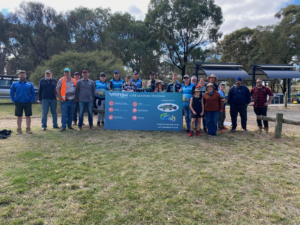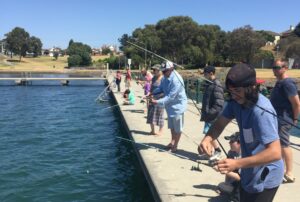December 24, 2019
Another summer and another case of a high-flowing lower Goulburn River to meet water demands further downstream. In recent years the river has been used Victoria’s largest water pipe and its not good for river health and its bad news for our native fish.
Last week the Murray-Darling Basin Authority ordered 50GL as part of an Inter-Valley Transfer (IVT) to be sent down to the Murray River for downstream water users and to also maintain water levels in the ‘off-river’ storage of Lake Victoria, South Australia.
Unseasonal water flows in summer plays havoc with our native fish natural time clock and water is much colder. Normally this time of year water temperatures should be on the rise which get the fish on the bite as they are right in the middle of their growing season. Juvenile fish born over the spring need calm, warm and productive waters not a fast flowing river.
Consistent high flows in the lower Goulburn River have caused erosion of the lower bank and the loss of trees and vegetation that stabilise the river banks. The loss of fish habitat and increased erosion means a muddier river and higher rates of siltation of deep refuge pools.
VRFish conducted an Inland Recreational Fishing Survey at the start of 2019 and found that 29% of recreational fishing occurs on the Goulburn River, making it Victoria’s most popular river. Anything that adversely impacts the Goulburn River is a big issue for Victorian recreational fishers.
Earlier this year, VRFish welcomed the decision by Victorian Water Minister Lisa Neville to protect the Goulburn River and cap the amount of water allowed to be sent down the Goulburn.
While IVT have been capped at 50GL per month for the Goulburn River. More work needs to be done. The Water Minister also announced public consultation will occur early in the new year on long-term options that properly considers the environmental damage of unseasonal high flows.
In the meantime, Goulburn-Broken CMA and Goulburn Murray Water will be working hard to see what they can do to deliver the water as creatively as they can.
Rather than allowing the bank vegetation to be inundated for extended periods of time and subsequently dying, water can be delivered in short larger pulses to minimise environmental damage. Some water can also delivered by the Campaspe River and Lower Broken Creek.
Why is this happening? The fact is, most of the water would have normally been delivered by the Darling River and the Murrimbidgee Rivers. With the droughts in NSW and QLD the bulk of the available trade-able water in the Murray-Darling Basin is in Victoria.
From our perspective, it appears this scenario has never been planned for as part of the Murray-Darling Basin Plan. If it wasn’t for the Victorian Government stepping in we would be seeing even more water heading down the Goulburn River this summer. Clearly the Murray-Darling Basin plan needs fixing but until it starts to rain in NSW and QLD and rivers flow, there isn’t much more anyone can do reduce IVTs back to ‘normal’ historical levels in this drought scenario.
Long-term, fishers are already raising concerns with what these large water releases are doing water levels of our reservoirs such as Lake Eildon, which is one of Victoria’s most revered recreational fishery.
Prior to 2013-14, the average amount of water delivered by the Goulburn River to the Murray as part of IVT averaged 60GL. It has now increased to 320GL in 2017-18 and 433GL in 2018-19.








